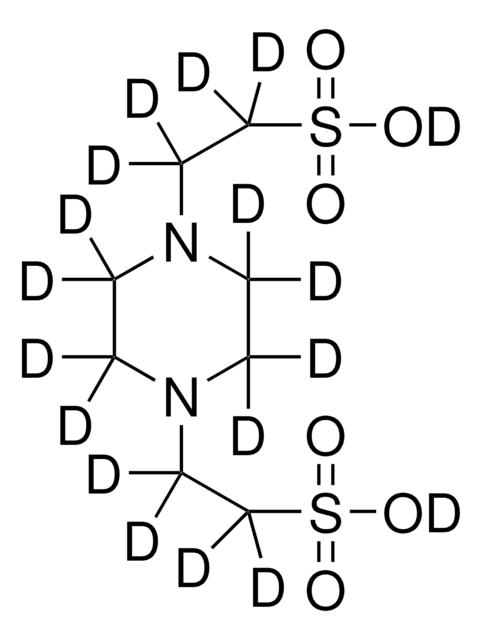If this product has an expiration or retest date, it will be shown on the Certificate of Analysis (COA, CofA). If there is no retest or expiration date listed on the product's COA, we do not have suitable stability data to determine a shelf life. For these products, the only date on the COA will be the release date; a retest, expiration, or use-by-date will not be displayed.
For all products, we recommend handling per defined conditions as printed in our product literature and website product descriptions. We recommend that products should be routinely inspected by customers to ensure they perform as expected.
For products without retest or expiration dates, our standard warranty of 1 year from the date of shipment is applicable.
For more information, please refer to the Product Dating Information document: https://www.sigmaaldrich.com/deepweb/assets/sigmaaldrich/marketing/global/documents/449/386/product-dating-information-mk.pdf
Wichtige Dokumente
P6757
PIPES
≥99% (titration)
Synonym(e):
1,4-Piperazindiethansulfonsäure, Piperazin-1,4-bis(2-ethansulfonsäure), Piperazin-N,N′-bis-(2-ethansulfonsäure)
About This Item
Empfohlene Produkte
Qualitätsniveau
Assay
≥99% (titration)
Form
crystalline powder
Nützlicher pH-Bereich
6.1-7.5
pKa (25 °C)
6.8
mp (Schmelzpunkt)
>300 °C (lit.)
Löslichkeit
1 M NaOH: 20 + 80 mL g, clear, colorless
Anwendung(en)
diagnostic assay manufacturing
SMILES String
OS(=O)(=O)CCN1CCN(CC1)CCS(O)(=O)=O
InChI
1S/C8H18N2O6S2/c11-17(12,13)7-5-9-1-2-10(4-3-9)6-8-18(14,15)16/h1-8H2,(H,11,12,13)(H,14,15,16)
InChIKey
IHPYMWDTONKSCO-UHFFFAOYSA-N
Suchen Sie nach ähnlichen Produkten? Aufrufen Leitfaden zum Produktvergleich
Allgemeine Beschreibung
Anwendung
Die alkalische Phosphatasen-Aktivität geht bei bestimmten Hepatozyten-Organellen der Ratte selektiv verloren, wenn mit Cacodylat gepuffertes Glutaraldehyd für die Ultrazytochemie verwendet wird. Bei Verwendung von PIPES als Puffer war die Erhaltung der Aktivität um 60 % besser.[4]
Die Fixierung von Pilz-Zoosporen für die Fluoreszenzmikroskopie und Elektronenmikroskopie war optimal bei Verwendung einer Kombination aus Glutaraldehyd und Formaldehyd in PIPES-Puffer.[5]
Verlinkung
Angaben zur Herstellung
Lagerklassenschlüssel
11 - Combustible Solids
WGK
WGK 3
Flammpunkt (°F)
Not applicable
Flammpunkt (°C)
Not applicable
Persönliche Schutzausrüstung
Eyeshields, Gloves, type N95 (US)
Hier finden Sie alle aktuellen Versionen:
Analysenzertifikate (COA)
Die passende Version wird nicht angezeigt?
Wenn Sie eine bestimmte Version benötigen, können Sie anhand der Lot- oder Chargennummer nach einem spezifischen Zertifikat suchen.
Besitzen Sie dieses Produkt bereits?
In der Dokumentenbibliothek finden Sie die Dokumentation zu den Produkten, die Sie kürzlich erworben haben.
Kunden haben sich ebenfalls angesehen
Verwandter Inhalt
Discover high-purity biological buffers for production scale. Ensure stability, pH control, and consistent supply with our expert manufacturing solutions.
-
How can I determine the shelf life / expiration / retest date of this product?
1 Antwort-
Hilfreich?
-
-
How is shipping temperature determined? And how is it related to the product storage temperature?
1 Antwort-
Products may be shipped at a different temperature than the recommended long-term storage temperature. If the product quality is sensitive to short-term exposure to conditions other than the recommended long-term storage, it will be shipped on wet or dry-ice. If the product quality is NOT affected by short-term exposure to conditions other than the recommended long-term storage, it will be shipped at ambient temperature. As shipping routes are configured for minimum transit times, shipping at ambient temperature helps control shipping costs for our customers. For more information, please refer to the Storage and Transport Conditions document: https://www.sigmaaldrich.com/deepweb/assets/sigmaaldrich/marketing/global/documents/316/622/storage-transport-conditions-mk.pdf
Hilfreich?
-
Aktive Filter
Unser Team von Wissenschaftlern verfügt über Erfahrung in allen Forschungsbereichen einschließlich Life Science, Materialwissenschaften, chemischer Synthese, Chromatographie, Analytik und vielen mehr..
Setzen Sie sich mit dem technischen Dienst in Verbindung.








